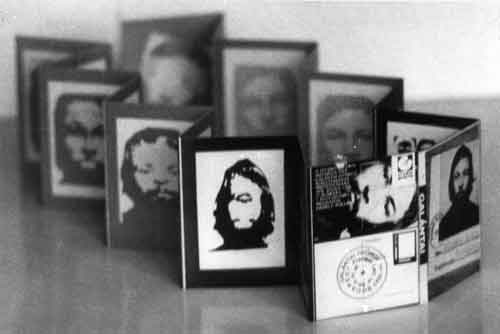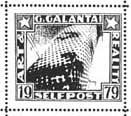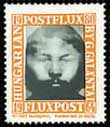György Galántai: In 1976, I took my picture in a photo automat for one of my identity cards. Several of my friends remarked on the impersonality of the picture. I decided to enlarge the picture, and try, using a variety of different photomechanical means, to arrive at the picture’s original meaning. I used traditional screens and every imaginable and available modifying device. I selected the devices according to the variety of modifications they were capable of. As a last resort, I treated the original photograph itself as a modifying device.
The conceptual core of the procedure I found, in effect, in the relationship between man and machine.
The purpose of the modification: a portrait developed from the interaction of reality components in an object-concept relationship.
The method of modification: the addition or substraction of two superimposed pictures, one being the constant and the other being the modifier. The result was a face which could function either as the constant or the modifier in the next procedure.
Portraits that could be modified no further I considered as facts, or, if you will, as objets trouvés, and I printed them in sequence, as one would treat a collection. There came into being the sequence of possible portrait-variations, a sequence suited for indefinite expansion. The individual portraits represent the different variants of the personality.

Studio Gallery, bookwork-catalogues, 1976 |  | postcard-invitation
| postcard-invitation
“As we turn the pages, the self-portrait itself retains less and less of its personal, self-expressing quality. It becomes the basic unit of a system of modules, a system suited for use in a variety of mechanical processes; at times, it seems to disappear entirely, so that only its absence is perceptible throughout. The principal player in this exercise in graphic modification, thus, is not some kind of motif, but the procedure itself, or, more precisely, its two prime devices: the photo negative, which essentially determined the image structure, and the fine silk-screen allowing or blocking the penetration of the dye.” (László Beke, 1978)
By reproducing a photo reduced to a size appropriate for a pattern, one can produce patterns suited for wallpapers, tablecloths or other household objects. The future of the pattern transformed into a household objects is determined by the use to which it is put; this is what motivates any further transformations. The motives of this transformation will, in effect, furnish new perspectives on the portraits that constitute the motif. The head motif will be further modified by manual intervention (tearing, blowing, burning, etc.), until it disappears completely.
In the next phase, the modification of the original machine photo (the artist’s self-modification) takes a new direction. The picture is enlarged into huge (3 x 4 m) transparencies and is set in a variety of landscapes, where it takes on entirely different meanings.
The photographic documents of this action finally end up as postal stamps in the “Art & Reality - Selfpost” (1979–95) series, just as the first portrait series ended up on the pages of “Postflux - Fluxpost” (1980).

